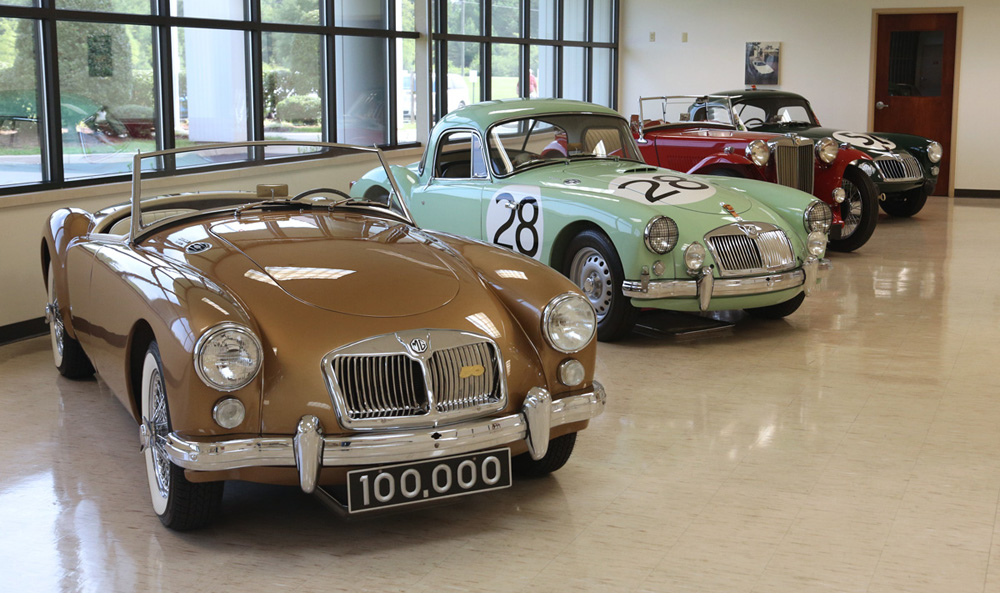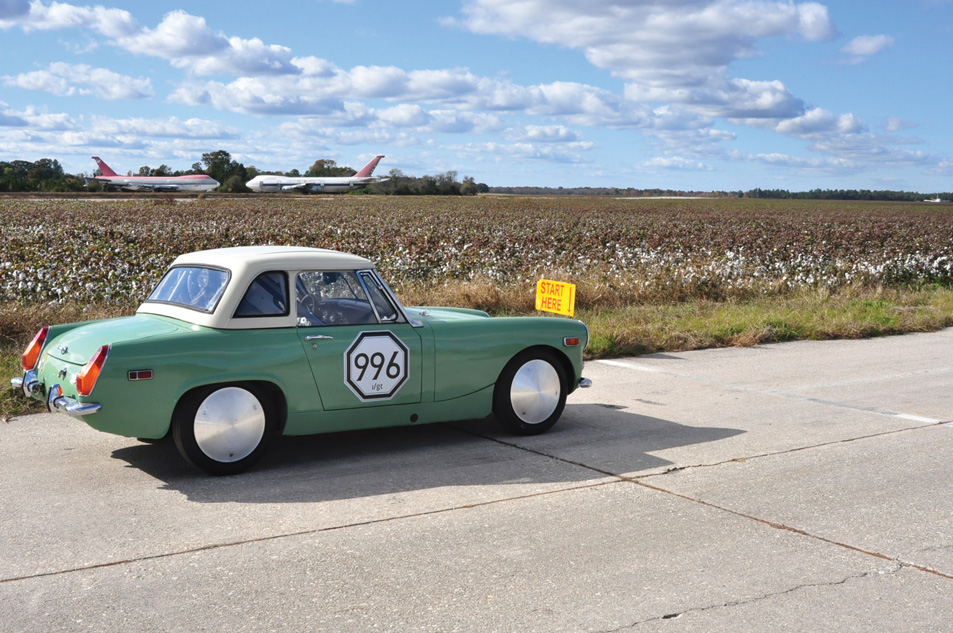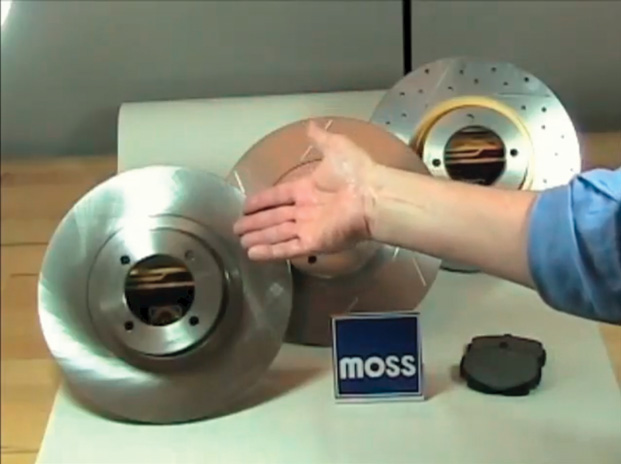How do you determine what gear ratio you have? Sages will tell you to look for numbers on the case, which is great if:
a. you can find them, and
b. the gear set hasn’t been changed by a nefarious past owner.
The easiest way to determine the gear ratio is to jack up the car (safely) and block one rear wheel so it can’t rotate. Most British cars have “open” differentials, where a spider gear causes the wheels to rotate opposite one another. If you block one, the other wheel spins twice as quickly. When driving, this allows the wheel on the inside of a turn to rotate slower than the one on the outside of the turn. With the transmission in neutral, rotate the unblocked wheel two full turns and note how many times the pinion flange of the differential rotates. Marking the wheel and flange with a white marker helps keep track of the rotations. The number of turns is the gear ratio, which is called out as number of turns of the differential pinion to one turn of the axle.
 So why is this number important?
So why is this number important?
The lower the number, the faster the car will go with the same number of engine revolutions. The higher the number the better the car will accelerate, but at the expense of high speed cruising.
Now for the confusing part of the story. A high numerical gear ratio is called a low gear or low rear end, and vice versa. Low gears give fast acceleration, high gears give better cruising.
A smaller engine will need a lower rear end to give adequate acceleration. A more powerful engine can use a higher rear end to give relaxed cruising and a higher top speed. So if you install a bigger, more powerful engine you probably want to change to a higher gear ratio from stock.
Shorter tires require a higher gearing to travel the same distance as a taller tire, so as tire sizes got smaller and engines produced more power, the gear ratios tended to get higher. That is why for instance an MGB with 14″ wheels was fitted with a 3.90 gear ratio and the earlier MGA with 15″ wheels had a lower gear ratio.
Here are some typical ratio numbers with the gear teeth counts (Pinnion/Crown Gear):
Big Healey: 4.10 10/41 3.90 11/43 3.545 11/39
MGT: 5.125 8/41 4.875 8/39
MGA: 4.30 10/43 4.10 10/41
MGB: 3.90 11/43
MGC: 3.07 14/43 3.30 13/43 3.70 10/37
Spridget: 4.22 9/38 3.90 11/43 3.73 11/41
TR2-6: 3.45 38/11 3.7 10/37 4.1 10/41
By Kelvin Dodd








'The Highs and Lows of Differential Gear Ratios' have 19 comments
October 21, 2013 @ 6:39 pm Gilbert
Thank you very much! My question was clearly answered in this site.
December 20, 2017 @ 12:46 pm Phil
Yes….thank you..now I can tell my Brother- in law…he is clear full of bull…and I was right…he thinks everyone is Stupid except him…and he never Graduated High school…cause he was to smart…
November 3, 2018 @ 10:39 am Sam
This is hilarious. I hated high school. It was such a pain in the arse. But I still graduated. And then college too. Doesn’t your brother know that you need to graduate to prove to people that you are smart?
December 4, 2013 @ 12:28 pm MASOUD
Hi, I have 1995 Mercedes-Benz which has problems with the Differential Gear of Gear Ratio 3.92. I can’t find a replacement. So is there an Equivalent Ratio Number such as 3.67?
Any help is appreciated.
THANK YOU
October 17, 2023 @ 11:25 pm Edward R Sohtun
My Jeep MM550 NGCS, has swap in with the 3000cc tata 407 motor mated to a kmt 90 4speed gearbox,
what differential ratio would be most suitable to achieve optimum fuel efficiency and 100+ cruising speed ?
March 29, 2015 @ 4:43 am Mercedes Sprinter rear axle ratios - Page 2 - Motorhome Forums, Motorhome Discussion, Motorhome Chat
[…] Happy to take advice, so I googled 'higher and lower gear ratios', here are the first 5 results. http://mossmotorsltd.wpengine.com/the-high…l-gear-ratios/ and http://www.ehow.com/facts_7568829_di…ear-ratio.html and […]
February 26, 2016 @ 4:47 am salvador
Gud evening can ay ask question what is the possible cause if yuo run the car in a higher speed then hear a noise in the differential.
March 7, 2016 @ 5:19 pm Greg
Good description, the higher numerical ratio called a “low ratio”, and lower numerical ratio called a “higher ratio” allways got me confused… now I know why!
March 2, 2019 @ 3:05 pm George Cappello
When you shift from third to second you call in down shifting, first gear is sometimes called low gear. If your car has an overdrive it may take a 1 to 1 ratio from the transmission and make it something like .75 to 1, we don’t call that an under drive we call it an overdrive.
August 26, 2020 @ 10:29 pm New Bruce
That’s because the tail shaft turns 1 turn for every 3/4 turn of the engine. Therefore 1 engine turn equals 1.3 tailshaft turns, otherwise known as overdriven, or overdrive.
June 19, 2017 @ 4:00 am rico dags
my i ask what differential ratio is for high speed. mine is 9/38 or 4.22 but the van (hyundai grace) cant run up to 100kph…whats the better ratio to attain a hign speed. Thank you
June 25, 2017 @ 12:01 am Topher
Hyundai grace engine HP 70+ HP you need more horse power to attain 100kph or 120 140 kph. 100+ HP…. Install a turbo to you engine.. Or change motor.
March 6, 2018 @ 12:24 am paul betts.
dear sir, I have a 9 h.p. 1948 singer utility, at around 35 m.p.h. the engine seems to be racing. I would like to know if they have the same diff. as a
4 ab sports car or are they all the same? I do not know what the ratio is, can it be changed to a higher ratio?
thanks, paul
August 26, 2018 @ 5:04 pm Eric Cooper
I have. 2015 GMC Yukon 5.3 engine with a Superchips F5, K&N Air intake, air raid throttle body spacer, jet performance throttle body, pedal commander and flow master exhaust.
I would like to get a faster acceleration so what gear ratio should I set it to?
April 8, 2019 @ 7:27 pm Austin
Higher ratio/ faster spinning ratio but like the content said lower top speed as a result. Go with the highest gear diff ring and pinion set they make for your car just match up he size make sure it fits. For your big ass motor and car I’m sure they a 4.80 set. 4.10s are plenty in my opinion but fuck it go big or go home if ur plan is only 0-60 acceleration
November 14, 2018 @ 7:18 am Devin Crispin
Not about an engine at all, but I’m a sophomore in High School and I’m doing a project for engineering and I was wondering if I start with a higher gear ratio and work my way down to a lower gear ratio via a gearbox could that produce more kinetic energy that could then be converted into electricity? Instead of just having a single gear driving a converter and producing less kinetic energy?
April 2, 2019 @ 10:57 am dave
I want to improve cruising fuel economy on a 1980 camaro 305 that has 2.56 to 1 ratio, can I find something with a closer ratio? this will be used for cruising, not racing
April 8, 2019 @ 7:31 pm Austin
Your ratio is ideal already for gas mileage. Check into a gas chip plugs in where your check engine connection is and within 100 miles it will adjust to driving and improvise your gas by using a better air fuel mixture and pushing less pressure into your fuel injectors as a result less gas is combusted and less gas is wasted at the cost of a little power ecu power tho.
April 12, 2021 @ 4:18 pm Sean preddie
I did a conversion on a Hiace 2001 I took diesel out and put 1g gas engine currently running 9/41 differential but it’s wining out what the best ratio to carry load